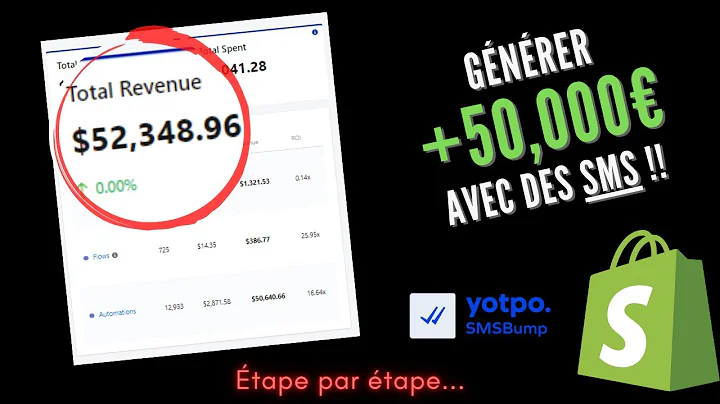Guide d'installation de Google Tag Manager sur Shopify
Table of Contents
- Introduction
- What is Google Tag Manager?
- Benefits of Using Google Tag Manager
- How to Install Google Tag Manager on a Shopping Site
- Creating a Google Tag Manager Account
- Installing the Google Tag Manager Container on Your Site
- Verifying the Installation of Google Tag Manager
- Advanced Features of Google Tag Manager
- Custom Variables
- Triggering Tags
- Debugging and Previewing Tags
- Best Practices for Using Google Tag Manager
- Keep Your Container Organized
- Use Descriptive Names for Tags and Triggers
- Test Your Tags Before Publishing
- Conclusion
How to Install Google Tag Manager on a Shopping Site
If you're running a shopping site, you know how important it is to track user behavior and measure the effectiveness of your marketing campaigns. One of the best tools for doing this is Google Tag Manager, which allows you to install tracking tags on your site without having to modify your code.
What is Google Tag Manager?
Google Tag Manager is a free tool that allows you to manage and deploy marketing and analytics tags (snippets of code) on your website or mobile app. With Google Tag Manager, you can add and update tags without having to modify your website's code, which makes it a great tool for marketers and website owners who don't have a lot of technical expertise.
Benefits of Using Google Tag Manager
There are several benefits to using Google Tag Manager on your shopping site:
-
Saves time and resources: With Google Tag Manager, you can add and update tags without having to involve your development team, which can save you time and resources.
-
Improves website performance: By reducing the amount of code on your website, Google Tag Manager can help improve your website's performance and load times.
-
Provides greater flexibility: With Google Tag Manager, you can easily add and remove tags as needed, which gives you greater flexibility in managing your marketing and analytics tools.
How to Install Google Tag Manager on a Shopping Site
Installing Google Tag Manager on your shopping site is a relatively simple process. Here's how to do it:
Step 1: Creating a Google Tag Manager Account
The first step in installing Google Tag Manager is to create an account. To do this, go to the Google Tag Manager website and sign in with your Google account. Once you're signed in, you'll be prompted to create a new account.
Step 2: Installing the Google Tag Manager Container on Your Site
Once you've created your Google Tag Manager account, the next step is to install the Google Tag Manager container on your shopping site. To do this, you'll need to add the Google Tag Manager code to your site's HTML.
To add the Google Tag Manager code to your site, follow these steps:
- Log in to your shopping site's backend.
- Navigate to the "Theme" section and click "Edit Code."
- Find the "theme.liquid" file and click to open it.
- Scroll down to the end of the file and paste the Google Tag Manager code just before the closing
</body> tag.
- Save the file.
Step 3: Verifying the Installation of Google Tag Manager
Once you've installed the Google Tag Manager container on your shopping site, you'll need to verify that it's working correctly. To do this, you can use the Google Tag Assistant Chrome extension.
To verify the installation of Google Tag Manager, follow these steps:
- Install the Google Tag Assistant Chrome extension.
- Navigate to your shopping site and click the Google Tag Assistant icon in your browser's toolbar.
- Click "Enable" to start recording.
- Refresh your shopping site.
- Click "Disable" to stop recording.
- Click "Show Full Report" to view the results.
If the Google Tag Assistant reports that Google Tag Manager is installed and working correctly, you're all set!
Advanced Features of Google Tag Manager
Google Tag Manager offers several advanced features that can help you get even more out of your tracking tags. Here are a few of the most useful features:
Custom Variables
Custom variables allow you to create your own variables that can be used in your tracking tags. This can be useful for tracking custom events or user behavior that isn't covered by the default variables.
Triggering Tags
Triggering tags allow you to specify when your tracking tags should fire. For example, you might want to fire a tag when a user clicks on a specific button or visits a specific page.
Debugging and Previewing Tags
Google Tag Manager includes a built-in debugging and previewing tool that allows you to test your tags before publishing them. This can help you catch errors and ensure that your tags are working correctly.
Best Practices for Using Google Tag Manager
To get the most out of Google Tag Manager, it's important to follow some best practices. Here are a few tips:
Keep Your Container Organized
As you add more tags to your container, it can become difficult to keep track of everything. To avoid confusion, it's a good idea to keep your container organized by using descriptive names for your tags and triggers.
Use Descriptive Names for Tags and Triggers
Using descriptive names for your tags and triggers can help you quickly identify what each one does. This can be especially useful if you're working with a team of marketers or developers.
Test Your Tags Before Publishing
Before publishing your tags, it's important to test them to ensure that they're working correctly. Google Tag Manager includes a built-in debugging and previewing tool that makes it easy to test your tags before publishing them.
Conclusion
Google Tag Manager is a powerful tool that can help you track user behavior and measure the effectiveness of your marketing campaigns. By following the steps outlined in this article, you can easily install Google Tag Manager on your shopping site and start reaping the benefits of this powerful tool.






















